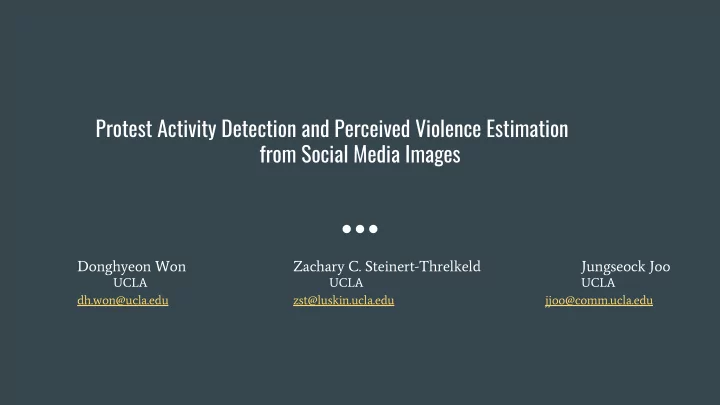

Protest Activity Detection and Perceived Violence Estimation from Social Media Images Donghyeon Won Zachary C. Steinert-Threlkeld Jungseock Joo UCLA UCLA UCLA dh.won@ucla.edu zst@luskin.ucla.edu jjoo@comm.ucla.edu
Introduction Great impact of social media on protests ● Limited by formal and quantitative models (protestor survey, etc.) ● ● More images are being shared but scholars have yet to analyze what they show Focus on violence in protests ●
Related work Little work in the fields of political science and media studies which attempts to ● automatically analyze visual or multimodal data due to the lack of proper methods and datasets Large-scale visual content analysis to tackle related research questions in political ● science, media studies and communication focus on facial attribute classification (age, gender, race) ● Public opinion about politicians has been also studied in relation to visual portrayals and persuasions in mass media
Dataset 40764 images ● Geotagged tweets ● ● 11,659 images are protest images identified by annotators and the rest are hard-negative images (e.g., crowd in stadium). This paper analyzes and compares five protest events including Black Lives ● Matter and Women’s March.
Dataset The model aims to distinguish between a protest crowd and other large gathering ● such as concerts or sporting events. It should also distinguish between non-violent and violent protests. Trained rough Convolutional neural network based on positives examples and ● negative examples (concerts, stadium, flash mobs) Used Amazon Mechanical Turk (AMT) to obtain necessary annotations for each ● image in the dataset
Dataset
Models CNN taking a full image as input ● Series of prediction scores as output. Including the binary image category(i.e., ● protest or non-protest) (1), visual attributes (10), and perceived violence and image sentiment (1+4) Jointly trained the model such that all parameters for 3 different tasks – protest ● classification, violence and sentiment estimation, and visual attribute classification – are updated jointly
Models 1. In addition, another CNN captures various facial attributes from images. 2. OpenFace for face models (developed for face recognition) 3. Celeb A facial attribute dataset to train the attribute model. 4. For each image, dlib’s face detection and alignment crops the internal facial region to feed into the facial CNN model.
Results
Results
Conclusion New approaches to estimate violence and protest dynamics from social media ● images ● Primarily visual method of analysis Large training data set ● Collaborative area of research between multimedia and political science ●
Recommend
More recommend